Abstract
While climate change urges cities to define appropriate strategies for climate adaptation, urban planning practices are still unable to encompass a broader understanding of hydraulic hazards and to exploit the mitigation potential of nature-based solutions (NBS) for stormwater management. This inability is particularly deep in the Italian context, where the integration of climate adaptation strategies within urban planning is very limited; thus, one of the planner’s overriding needs is to determine where NBS can be most effective. The objective of this paper is to identify key drivers and tools for the introduction of hydrological resilience assessments and sustainable storm water management in urban planning practices, as a contribution to climate adaptation strategies. Through a case study in the city of Bari, the paper proposes a method for identifying the most suitable urban areas for implementing NBS, i.e., areas where NBS are able to intercept runoff. On the other hand, the same approach allows one to evaluate in advance the impact of urban planning choices, or rather of the planned land use change. Finally, the planning tools that may favor the adoption of a NBS approach in urban planning are analyzed, with particular reference to the territorial landscape plan of the Apulia region and urban regeneration plans.
1. Introduction
Climate change is now a fact on a global scale. Temperatures are increasing while the precipitation patterns change, especially from the point of view of concentration over time, therefore with the alternation of drought and violent showers. From a territorial point of view, situations of thermal stress caused by heat waves and floods are leading to greater climatic danger, both thermal and hydrological [1].
In the last report, the European Environment Agency [2] underlined how several European governments and organizations have already developed policies and laws at national and regional levels to support cities in the implementation of appropriate measures for climate change adaptation, following the input by the European Strategy on Adaptation to Climate Change.
Both the increasing frequency of extreme events and a general awareness and concern among citizens, stakeholders, and decision-makers have aroused considerable attention for these issues. Less attention is instead devoted to land use change processes, which, if they seal the soil, amplify the effects of climatic extremes [3,4].
It is therefore necessary to find new land management strategies, as indicated by the European Strategy, with national, regional, and local plans for adaptation to climate change to be made by member states. This resulted, for example, in the Adapt Agreement of European Mayors (http://mayors-adapt.eu, accessed on 11 May 2022), which involves municipalities on climate change and provides support for the implementation of adaptation actions at the local level. Indeed, the municipal scale appears to be the most effective, also because it is the municipalities that manage land use, through urban planning.
Some Italian municipalities have drawn up a Climate Adjustment Plan, but these are still very timid actions, primarily due to the lack of binding legislation, both at the national and regional level. More research is also needed to innovate know-how to pursue these new challenges.
The settlement system needs to be rethought, going beyond the traditional “structural” objective (exclusively pursued through infrastructural works) of reducing climate risks and aiming, instead, at strengthening the resilience of the territories. For this purpose, solutions based on nature are needed, which reduce instability through the greater permeability of the territory, which is a real ecosystem service provided by green areas, both public and private [5].
The “Climatic Resilience Study” and the hydro-climatic invariance of each urban settlement are therefore important tools for the conscious identification of adaptation strategies suitable for real local needs. This study should include the most appropriate interventions with respect to the territorial hazard, which is always very specific; therefore, it is necessary to distinguish different areas and different practices also because the location of the interventions is essential to establish their effectiveness and efficiency.
Focusing the attention on land planning, two essential lines of study follow: (i) the assessment and mitigation of the impacts when they have already manifested themselves; (ii) the increase of the resilience of the territory, so it can adapt to the scenarios of change and prevent hazard, since making the soils more permeable means that the territory is more suitable for absorbing heavy rains.
In consequence, in both cases, prevention is essential and can be implemented through the appropriate planning and design of the territory. As with all complex problems, management and solutions have numerous approaches, which need to be integrated; that of planning is particularly important because it can act on land use, therefore on the root causes of problems and prevention.
The theme addressed in this paper is the hydrological hazard, considered from a land use point of view, because land use, influencing greatly soil permeability, has a huge impact. Soil sealing due to urbanization reduces the absorption capacity of intense rains, so the runoff can be increased by even 7–800% [6]; additionally, intensive agriculture has a considerable weight in producing hydraulic danger on the territory [7] with a far greater effect than any climatic scenario, even the most pessimistic. Subsequently, Ericksen’s lucid analysis of 1986 (“Creating Flood Disasters?”) [8] deserves further mention, with his rhetorical question on the manmade causes of hydrogeological hazards.
It is therefore urgent to focus on the real genesis of danger, which is the unsustainable use of the territory. In this context, this article addresses the problem at the urban scale, in which management practices have considerable importance, also because they are based on greenery, and green areas have a multifunctional role for urban quality.
In the literature, these practices are known as nature-based solutions (NBS) defined as engineered green/ecological systems inspired by, supported by, or copied from nature [9]. They are important because they can support the transition of social-ecological systems towards more sustainable environments. NBS can be part of a sustainable and cost-effective strategy for the improvement of the hydrological resilience of urban systems, increasing their complexity tanks to functional greening, and reducing the ecological footprints of cities. In most cases, they are not alternatives to conventional grey infrastructures (i.e., sewers) but complement them and reduce their impact and costs.
The objective of this paper is to contribute to the introduction of hydrological resilience assessments and sustainable storm water management in urban planning practices in the context of climate adaptation plans. Thus, through a case study, an analysis is made of how urban development impacts the hydraulic hazard and how the awareness of these impacts, in the planning phase, can prevent and mitigate the hazard itself. In this way, the proposed approach also makes a contribution to the strategic environmental assessment of urban plans.
To achieve this, it is essential first of all to establish the real capacity of the urban areas in which NBS can be located, because not all are suitable. The scientific literature proposes various evaluation methodologies [10] but the first step is to understand if the NBS are really capable of intercepting the runoff.
On this issue, the scientific literature is less developed and this paper wants to make a contribution to enrich it. NBS have to be integrated at a landscape scale, fully integrated with the built environment and to grey infrastructures, providing a diversified array of urban ecosystem services to the urban socio-ecological system. In fact, NBS bear a wide range of urban ecosystem services such as habitat provision, cooling effect, carbon storage, water pollution, and recreational functions [11,12]. Furthermore, since NBS are based on plant systems, biomass production cycles can trigger virtuous chains of energy production. Moreover, proximity to urban green areas may increase the sale price of houses [13].
NBS are landscape structures, so their development may contribute to the promotion of the holistic landscape concept introduced by the European Landscape Convention (ELC). This acknowledges the importance of the landscape for the improvement of the quality of life of people in urban areas as well as in the countryside, in outstanding places as well as in everyday and even degraded areas [14]. The Italian Cultural Heritage and Landscape Code has incorporated the new European conception in the national legislation, overcoming the “old” approach exclusively based on aesthetic and cultural aspects. The landscape management based on the ELC principles may thus contribute to the introduction of NBS principles into planning at different scales. On the other hand, the increased incorporation of NBS landscape structures into planning may support an effective implementation of the ELC principles within real planning practices. This paper also makes a contribution in this direction.
2. Materials and Methods
2.1. Study Area
The case of Bari, which is the regional capital of the Apulia region, is analyzed in this paper, with a focus on the San Paolo neighborhood. This is a social housing settlement of about 30,000 inhabitants, out of a total 315,000 inhabitants of the Bari municipality. It is located about 7 km from the city center (see Figure 1), in between the international airport, the interport, and the industrial estate of the metropolitan city’s industrial development consortium (ASI), which is one of the largest in southern Italy.
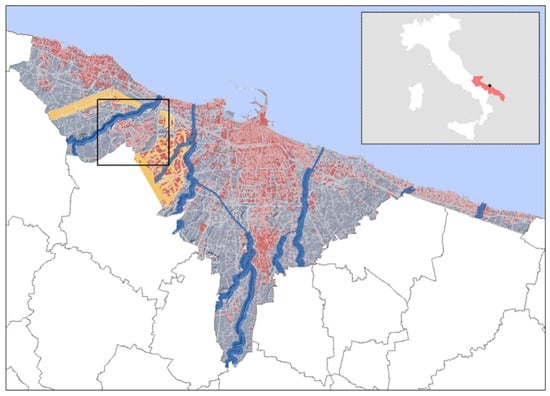
Figure 1.
Study area within the Bari municipal area.
Bari urban development is still ruled by a very old master plan (Piano Regolatore Generale—PRG), whose reductionist and pro-growth perspective lacks any environmental sensitiveness. The PRG was drafted in the 1970s and finally approved in 1976; it was conceived of as a means to strengthen the primacy of the city as regional capital of Apulia and its role as a growth pole in the region [15]. Based on a forecast of massive population increase (from slightly more than 350,000 inhabitants in 1970 to as many as 628,577 in 2011), it envisaged an impressive expansion of built-up areas—additional 20.5 million cubic meters for residential buildings, 7.5 MCM for the tertiary sector, 6 MCM for industrial development besides the ASI estate—as well as of road and infrastructure networks [16]. As a result, only 48% of the municipal territory was to be left for agricultural and green areas. This oversizing of the plan, together with the complete lack of any environmental sensitivity and consciousness of potential risk genesis, has led to foreseeable development sites in very sensitive areas, too.
Despite the current population of Bari being smaller than in the 1970s, as the city started decreasing in the 1980s, about half of the planned building capacity has been implemented, with further densifications made through ad hoc norms outside planning rules and a current spare planned building capacity of 13 MCM [16]. This gigantic quantity, which would imply a huge soil consumption rate, further highlights the anachronism of the PRG and requires a deep change in urban development strategies.
The first nucleus of the San Paolo neighborhood was built between 1958 and the beginning of the 1960s, while a large social housing expansion was planned in 1963 in accordance with the Law 167/1962. The PRG then provided for additional areas for residential buildings and the tertiary sector, as well as for road connections to the rest of the city [17]. Nevertheless, the development of the San Paolo neighborhood has not fully matched the plan. In the social housing expansion of the 1960s, while residential buildings have been built, most of the areas for public services and facilities are still derelict, including by-law areas for public services (so called “urban standards”). The two large expansion areas for residential buildings and the tertiary sector (highlighted in red in Figure 2) have not been urbanized.
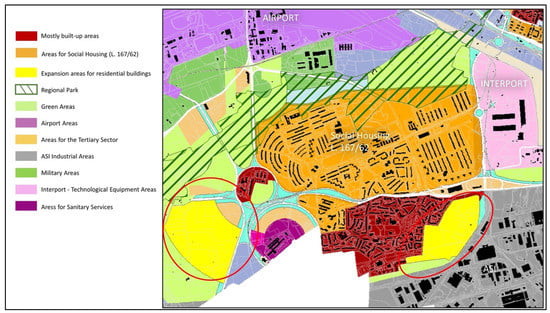
Figure 2.
Land use zoning map of the PRG of the Bari municipality, San Paolo neighborhood (own elaboration with data from the PRG zoning map). Highlighted in red: large expansion areas currently unbuilt in San Paolo.
For the area in the south-eastern part of the neighborhood, a proposal for a partial development with residential buildings, some social houses, and public service facilities has been drafted by private developers and discussed with the Bari municipality and the regional social housing agency. However, no formal process for the adoption and approval of that plan has started. For the area in the south-western part, an executive plan made by private developers has been formally submitted for approval to the Bari municipality, with the aim to build as much as 660,000 cubic meters of private residential buildings; that plan has been rejected due to the inconsistency of the proposal with the development scenarios foreseen by the new territorial landscape plan (TLP) of the Apulia region, approved in the meanwhile.
2.2. Materials and Methods for the Analysis of Alternative Development Scenarios
Alternative strategies for the development of the city of Bari are recently being proposed, based on the strategic vision of the TLP and on recent regional policies for integrated urban regeneration of deprived neighborhoods. Both the TLP and urban regeneration policies are rooted in an ecological perspective and aim to improve the quality of existing settlements and of the territory as a whole, while preventing urban sprawl and further soil sealing. The adoption of these visions at the local level would thus require a deep revision of urban planning strategies and tools [18]. Several obstacles may be encountered in this process, coming from institutional, economic, technical, and socio-cultural inertia to changes [19,20].
In this paper, the analysis of those alternative strategies is done, in order to assess their potential as effective drivers for the introduction of NBS and sustainable storm water management into urban planning in the context of climate adaptation. In the economy of the paper, the analysis has a focus on land use scenarios at a neighborhood level. For this purpose, the San Paolo neighborhood is selected, as this shows particularly striking conflicts between the pro-growth perspective of the old PRG and the new environmentally sensitive vision proposed by the TLP and regional policies for urban regeneration.
Data for the analysis of different planning strategies for the San Paolo neighborhood come from different sources, ranging from official documents (plans, programs, policy documents) to grey literature. The analysis has also drawn on semi-structured interviews with key informants.
2.3. Urban Water Flow Model
The impacts on hydraulic hazards of current and alternative development strategies for the San Paolo neighborhood is made through the elaboration of an urban water flow model. The study is focused mainly on areas that historically have flooding problems as reported by numerous testimonies from citizens who live in the area and by images that show the hydrological concerns. The problem of soil sealing caused by urban development may be mitigated by greening; therefore, an integrated set of NBS is strategic for this objective [4]. However, their location cannot be generic, because NBS can perform their stormwater mitigation potential if they are located where the runoff is generated [21], otherwise, their potential is severely limited.
For this reason, in this paper, the estimate of the water flow accumulation areas has been carried on, to understand where the runoff originates and develops. This clarifies the water–soil interaction and, therefore, aids in understanding if and to what extent the use of the soil amplifies the runoff (see the impermeable areas) or attenuates it, as occurs in the green areas. Therefore, it is obvious that this is a milestone of the urban green plan and project and, in general, of sustainable urban planning.
For the hydrological assessment of the study area, geographic information system (GIS) techniques have been used with the support of the ArcGIS 10.4.1 (Esri, Redlands, California, USA) software which provides a series of hydrological tools that have allowed, starting from the digital terrain model (DTM) mosaic on LiDAR data with a geometric resolution of 1 m, to build a series of thematic maps that have the same DTM as input. In particular, a series of elaborations of the study area have been developed using specific hydrological analysis functions of which the related input and output data are shown in the workflow model (Figure 3).
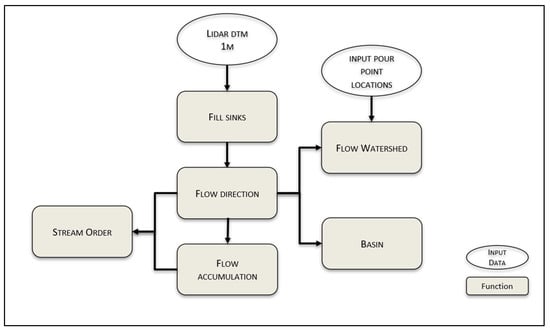
Figure 3.
Workflow model of principal hydrological function.
2.3.1. Fill Sinks
A sink is a depression in the ground in which it is not possible to determine the direction of the outflow to the external directions. The flow is therefore only entering the cell under examination and cannot leave it. This situation can be real when, for example, the point under consideration corresponds to the location of a sinkhole, but it could also be generated by a calculation error during the processing of the DTM. The purpose of this function is precisely to eliminate cells with these outliers by replacing them with an interpolation value of the values of the neighboring cells.
2.3.2. Flow Direction
The calculation model used to assign the flow direction of each cell is discussed by Marks [22] and O’Callaghan [23]; it consists in calculating the angle of all the cells close to it, identifying which of these has the value downward angle, and assigning it a numerical value among these: 128, 1, 2, 4, 8, 16, 32, 64 according to the direction.
2.3.3. Flow Accumulation
The flow accumulation assigns to each cell a value which expresses the cumulative weight of all the cells that converge on it. The result is a raster that represents an estimate of the water that flows into each cell, excluding the variables of evapotranspiration and infiltration.
2.3.4. Basin and Watershed
To determine the extent of a basin or watershed, it is necessary to define the “pour points” which identify the points where the closing sections of the basin are located.
The basin function has been used to calculate the basins of the entire study area, which automatically determines the closure sections of the individual basins, while specific “pour points” have been identified in the area to determine specific watersheds in the areas with greater hydrological criticality.
2.3.5. Stream Order
The stream order function allows for classifying the members of the hydrographic network in ascending order. In this regard, the Shreve algorithm [24] has been used, which assigns to each auction the sum of the values of the auctions that converge on the starting node of the auction under consideration as the order value.
3. Results
3.1. Alternative Land use Scenarios for the San Paolo Neighborhood
Alternative strategies for land use management—compared to those envisaged by the Bari PRG—are defined by the TLP, formally approved in 2015. In accordance with the scope and principles of the ELC, the TLP applies to the whole territory of the Apulia region—and not only to its unique or exceptional landscapes—with the final aim to foster a new identity-based local development [25]. In addition to defining a regulatory framework for the protection of landscapes of “extraordinary” value, it encompasses a strategic part aimed to direct all territorial transformations towards a more sustainable future. This is done through several innovative tools, including seven guidelines and five regional territorial projects.
The full implementation of the strategic vision of the TLP thus requires the revision of existing master plans, including land use zoning. The municipality of Bari started the development of its new master plan (Piano Urbanistico Generale, PUG) in 2007, before the approval of the TLP, and adopted the Preliminary Programmatic Document (DPP) for the PUG in 2011 [26,27]. New directives for its finalization were then passed in 2015, which underlined the need to adapt the PUG to the strategic vision of the TLP. The PUG development process is still ongoing, although currently it is in a stand-by phase.
The five regional territorial projects of the TLP are particularly challenging for the land use scenarios for the Bari municipality, as they further highlight the anachronism and the backward vision embedded in the old PRG. This applies, in particular, to the territorial project named “City-Countryside Pact”, whose overall aim is the development of a new alliance between urban and rural areas for the improvement of landscape and life quality. This is made through the reduction of soil consumption, the regeneration of urban margins and degraded landscapes in peri-urban areas, the development of greenbelts around cities, and of multifunctional agricultural parks in the countryside.
For San Paolo, as shown in Figure 4, this means to safeguard the undeveloped areas around the neighborhood to make them part of a greenbelt, with urban gardens and farms connected to the Lama Balice park and to a multifunctional agricultural park to be defined around the city of Bari, conceived of as a means to regenerate urban margins and to perform several ecosystem services, including hydrogeological ones.
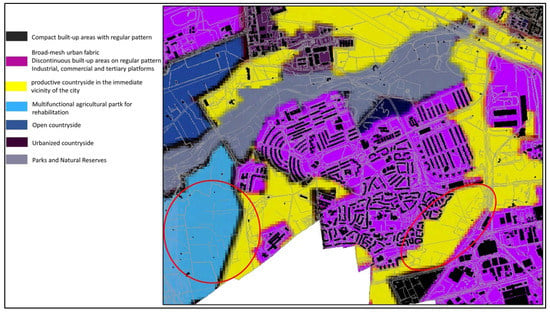
Figure 4.
Strategic areas of the city-countryside pact of the TLP, San Paolo neighborhood. Highlighted in red: localization of large PRG expansion areas currently unbuilt in San Paolo.
The implementation of both the greenbelt and the multifunctional agricultural park are in striking contrast with the land use zoning made by the PRG for the San Paolo neighborhood, which would instead allow new urban development through residential/tertiary areas and infrastructures in the two areas highlighted in red in Figure 4. Despite the pending revision of the existing PRG to comply with the TLP and the lack of a new master plan, this contrast has nevertheless constituted the basis upon which the Apulia region has denied the landscape permit for the executive plan proposed for the area on the south-west border of San Paolo, with the subsequent rejection of that plan.
Interesting directions for a new ecological vision for the city of Bari also come from the implementation of recent regional policies for integrated urban regeneration of deprived neighborhoods. The Regional Law n. 21/2008 “Norms for the urban regeneration” requires municipalities to adopt a Programmatic Document for Urban Regeneration (DPRU), whose strategy needs to combine physical regeneration with social inclusion and environmental sustainability. The DPRU should also identify the most deprived areas to be tackled by regeneration programs through a coordinated set of interventions, which explicitly include “the provision of ecological infrastructures such as green and blue networks designed to increase biodiversity in the urban environment”, as well as those aimed at saving resources, with particular reference to soil, water, and energy.
It is interesting to note that the inclusion of NBS into urban regeneration plans has been made mandatory by the regional government in case of co-funding through structural funds managed by the regional government—this was the case of regeneration initiatives promoted by the Apulia region through the 2007–2013 and 2014–2020 ERDF-ESF regional operational programs [28]. These funding rules may thus become a further important driver for the adoption of an NBS approach within regeneration initiatives and the innovation of urban planning practices. The contribution of this to the reduction of hydraulic hazards in urban environments would be significant, also in quantitative terms.
In the case of Bari, the municipality approved its DPRU in 2011 [29], as part of the DPP adopted in 2011. It identifies the San Paolo neighborhood as one of the target areas for urban regeneration, whose strategy should be aimed, on one side, to improve the quality of urban spaces and services as well as the railway connection to the city center and, on the other, to contrast soil consumption through a sort of greenbelt for agricultural activities with ecological and environmental functions linked to the Lama Balice park (see Figure 5). This is in striking contrast with the development provisions of the PRG.
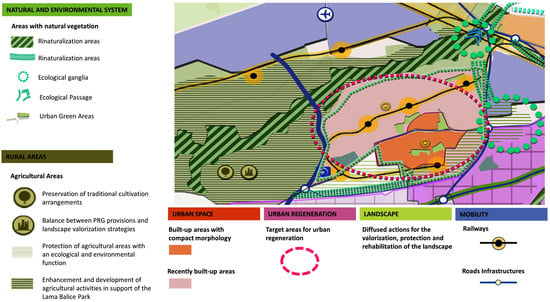
Figure 5.
Structural-strategic scheme of the DPRU of the Bari municipality, San Paolo neighborhood (own elaboration with data from the DPRU and from the Map SSS.TC.1 of the DPP—Source: [26,29]).
3.2. Water Flow Scenarios
An initial analysis made it possible to highlight how the San Paolo developed within the “Lamasinata Creek” (Lama Lamasinata) basin, and lays between Lama Balice and Lama Lamasinata (Figure 6).
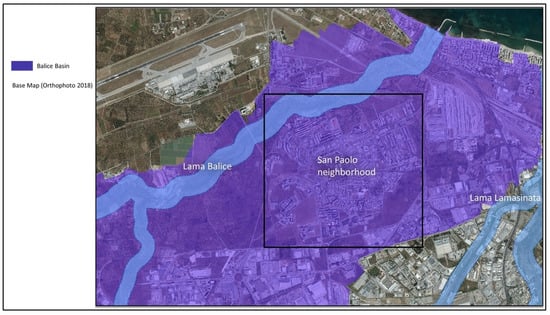
Figure 6.
Hydrographic basin and lame in the study area.
The elaborations summarized in Figure 7 clarify where the runoff is concentrated and, therefore, the areas susceptible to flooding. They are located within a watershed that feeds from a dense hydrographic network and with canals of particular accumulation and coincides with the area where the greatest reports of flooding have been collected.

Figure 7.
Water flow and built-up areas.
The old PRG foresees a very intense development, precisely in the runoff accumulation areas. This means to plan more and more impervious soils and, consequently, to greatly increase the hydraulic hazard. On the contrary, the numerous agricultural and wooded areas, if properly used for the settlement of NBS, could reduce it (Figure 8). For example, Pelorosso, Gobattoni, and Leone [4] have shown that 1 m2 of raingarden can absorb 10 to 40 m2 of urban runoff.
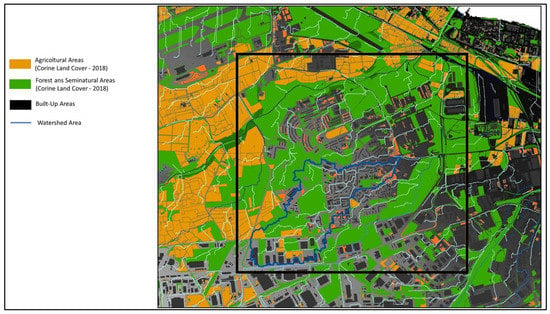
Figure 8.
Areas with NBS potential and built-up areas (source Corine land cover).
4. Discussion
The growing environmental awareness and sensitivity towards sustainability issues, together with the acknowledgement of the need to adapt to climate change, may provide an opportunity to innovate urban planning and to anchor it to a sound assessment of the environmental performance of planning choices. The case study analyzed in this paper highlights the relevance, from the point of view of the mitigation of the hydraulic hazard at the city level, of the increase of greenery in urban environments and may suggest key drivers for the introduction of those changes into urban strategies at the city and the neighborhood level.
In San Paolo, huge innovation potential, for a reversal of planning strategies, may come from the recent approval of the TLP of the Apulia region and by new regional policies for the regeneration of deprived neighborhoods. The definition of a greenbelt around the neighborhood, and of a multifunctional agricultural park around the city, foreseen by the strategic scenario of the TLP, may act as a key driver for an ecosystem-based turn in the development of the neighborhood and in the urban planning strategies of the Bari municipality. Both the greenbelt and the multifunctional agricultural park constitute, at different scales, tools for the promotion of an agro-urban and agro-environmental policy for the improvement of the landscape quality in the boundary spaces between the city and the countryside. These are the places where the implementation of NBS has the widest potential, as these may be managed in a multifunctional way and support, at the same time, ecological and hydrogeological functions, as well as socio-cultural and recreational activities [30].
The water–soil interaction analyzed in this paper confirms that green areas foreseen in the DPP/DPRU and in the TLP can play a fundamental role for hydraulic hazard mitigation. In fact, green structures such as NBS are able to absorb large amounts of runoff. For this, it is necessary that a green area can intercept the runoff to exercise its ecosystem service and this paper proposes a methodology for the identification of more suitable areas for NBS implementation. This is the case, for instance, of the area located in the south-eastern part of the San Paolo neighborhood, which presents the greatest criticalities due to the presence of the closing section of one of the watersheds (Figure 9) of the area. In that case, the TLP has proved to be a fundamental tool for environmental protection and constituted the basis for the rejection of the executive plan foreseeing expansion with residential buildings according to the PRG provisions.
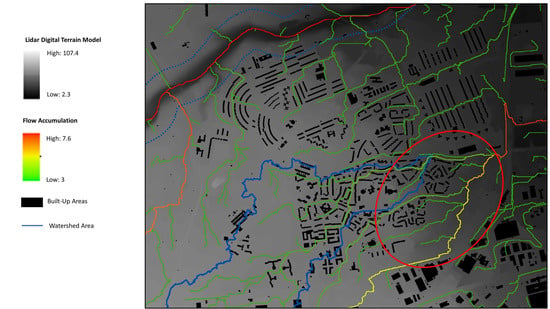
Figure 9.
Critical watershed in expansion areas for residential buildings.
This assessment is a prerequisite both to the general plan of adaptation to climate change and to the quantitative hydrological assessment [4,30] which allows it to make a quantitative estimation of the ecosystem service provided by NBS. To this is added, in synergy, the multifunctionality of the main NBS spaces, which increase biodiversity in the urban environment, are leisure areas, help to mitigate the urban heat island, etc.
In the San Paolo case, interesting potential to introduce resilience assessments and sustainable storm water management in urban planning may also be found in the regeneration of several derelict areas within the neighborhood, where public service facilities should have been built according to the plan. Through the use of NBS, the development of those areas may provide at the same time public services and several ecosystem services connected to water and energy saving, hydrogeological and ecological protection, and recreation. Thus, the undeveloped and semi-natural areas within the San Paolo neighborhood, that at present do not have a precise use and are mostly derelict (Figure 10), represent a great opportunity for ecosystem services. At the same time, they would also serve as an ecological network across the settlement.
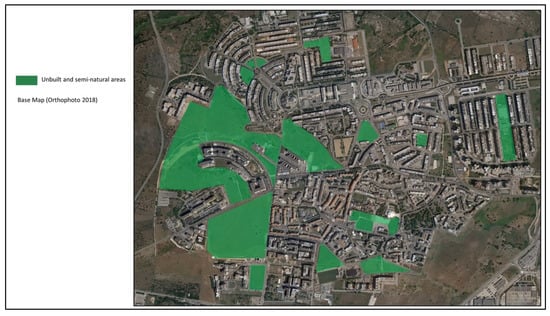
Figure 10.
Undeveloped and semi-natural areas within the San Paolo neighborhood with potential to serve as an ecological network.
5. Conclusions
The urban planning system in Italy has been traditionally influenced by what has been called the “urbanism tradition”, i.e., a regulatory/conformative approach exerted through land use zoning plans [31]. The pro-growth rhetoric and the lack of environmental sensitivity, which informed most of them, have led to huge amounts of soil sealed even in very sensitive areas, as well as to the neglection of potential risk genesis. In this context, storm water management has been regarded as a problem to tackle through appropriate design of technical infrastructures upon a definition of urban land use, rather than an opportunity to introduce a more holistic approach to urban functioning and design within urban planning [32,33].
The case analyzed in this paper is an exemplary case of how traditional planning failed to integrate sustainable stormwater management within its scopes and concerns. Nevertheless, the analysis of alternative land use scenarios for the San Paolo neighborhood, promoted by the TLP and by new regional policies for urban regeneration, and the assessment of their positive hydrological implications through a water flow simulation model, suggests interesting pathways for future integration of hydrological resilience assessment within urban planning.
The work presented in this paper demonstrates how hydrological sustainability can be pursued intrinsically to the plan. This takes place through the proposal of a new NBS localization methodology, which takes on a double value:
- (1)
- In the strategic environmental assessment phase, it guides the plan and, indeed, becomes a perfect integral part of it;
- (2)
- In the phase of urban landscape management and planning of the adaptation of the city to climate change.
These findings are particularly challenging in the Italian context, where the integration of climate adaptation strategies within urban planning is very limited, especially in southern Italian cities [34,35,36] and the penetration of NBS approaches to storm water management within planning practices is very scarce. Appropriate drivers thus need to be found to support this turn in planning practice. This is a quite challenging task, as this is not simply a matter of providing new tools and competencies to planners; much broader innovations are needed encompassing governance changes [37,38], social and institutional factors, as well as organizational and regulatory development [33,39].
This paper contributed to fill this gap, too, as it not only suggested a model for the first-step analysis of the hydraulic impact of urban development and of the mitigation potential of greenery, to be used by planners to improve their understanding of the hydrological functioning of the city; it also identified potential key drivers for the penetration of NBS approaches to storm water management within urban planning. The analysis showed that, in the Apulian case, a pivotal role may be played by the TLP, thanks to the multiple levels through which its strategy-oriented approach is innovating planning practices besides the compliance process requested by law to existing plans. Similarly, regeneration plans inspired by the Regional Law 21/2008 may act as a broader framework through which to support the NBS turn through multifunctional interventions, as indicated in the paper.
Author Contributions
A.L.: Conceptualization; methodology; writing—original draft preparation (Section 1 and Section 5); writing—review. L.G.: Conceptualization; methodology; investigation; writing—original draft preparation (Section 2.1, Section 2.2, Section 3.1, Section 4, and Section 5); writing—review and editing. P.B.: Conceptualization; methodology; data curation; writing—original draft preparation (Section 2.3, Section 3.2, and Section 4); visualization. All authors have read and agreed to the published version of the manuscript.
Funding
This research received no external funding.
Institutional Review Board Statement
Not applicable.
Informed Consent Statement
Not applicable.
Data Availability Statement
Not applicable.
Conflicts of Interest
The authors declare no conflict of interest.
References
- ESPON. ESPON Climate—Climate Change and Territorial Effects on Regions and Local Economies in Europe. 2021. Available online: www.espon.eu/climate (accessed on 7 December 2021).
- EEA. Urban Adaptation in Europe: How Cities and Towns Respond to Climate Change. EEA Report No. 12/2020; Publications Office of the EU: Luxembourg, 2020. [Google Scholar]
- Pelorosso, R.; Leone, A.; Boccia, L. Land Cover and Land Use Change in the Italian Central Apennines: Comparison among Assessment Methods. Appl Geogr. 2009, 29, 35–48. [Google Scholar] [CrossRef]
- Pelorosso, R.; Gobattoni, F.; Leone, A. Increasing Hydrological Resilience Employing Nature-Based Solutions: A Modelling Approach to Support Spatial Planning. In Smart Planning: Sustainability and Mobility in the Age of Change; Papa, R., Fistola, R., Eds.; Springer: Cham, Switzerland, 2018; pp. 71–82. [Google Scholar]
- Gobattoni, F.; Pelorosso, R.; Piccinni, A.F.; Leone, A. The Sustainability of the Urban System From a Hydrological Point of View: A Planning Practice Proposal. UPLanD 2017, 2, 101–122. [Google Scholar]
- Chow, W.T. Handbook of Applied Hydrology; Mc Graw-Hill: New York, NY, USA, 2010. [Google Scholar]
- Leone, A.; Gobattoni, F.; Pelorosso, R.; Balena, P. L’uso del suolo agricolo è il fattore chiave per la sicurezza dei territori fragili. In Proceedings of the XXII Conference SIU: L’urbanistica Italiana di Fronte all’Agenda 2030, Bari, Italy, 5–7 June 2019; pp. 857–862. [Google Scholar]
- Ericksen, N.J. Creating Flood Disasters? New Zealand’s Need for a New Approach to Urban Flood Hazard; Water and Soil Directorate, Ministry of Works and Development: Wellington, New Zealand, 1986.
- EU. Towards an EU Research and Innovation Policy Agenda for Nature-Based Solutions & Renaturing Cities; CEC: Brussels, Belgium, 2015. [Google Scholar]
- Senes, G.; Ferrario, P.S.; Cirone, G.; Fumagalli, N.; Frattini, P.; Sacchi, G.; Valè, G. Nature-Based Solutions for Storm Water Management—Creation of a Green Infrastructure Suitability Map as a Tool for Land-Use Planning at the Municipal Level in the Province of Monza-Brianza (Italy). Sustainability 2021, 13, 6124. [Google Scholar] [CrossRef]
- Haase, D.; Larondelle, N.; Andersson, E.; Artmann, M.; Borgström, S.; Breuste, J.; Gomez-Baggethun, E.; Gren, Å.; Hamstead, Z.; Hansen, R.; et al. A quantitative review of urban ecosystem service assessments: Concepts, models, and implementation. Ambio 2014, 43, 413–433. [Google Scholar] [CrossRef] [PubMed]
- Gómez-Baggethun, E.; Barton, D.N. Classifying and valuing ecosystem services for urban planning. Ecol. Econ. 2013, 86, 235–245. [Google Scholar] [CrossRef]
- Green, O.O.; Garmestani, A.S.; Albro, S.; Ban, N.C.; Berland, A.; Burkman, C.E.; Gardiner, M.M.; Gunderson, L.; Hopton, M.E.; Schoon, M.L.; et al. Adaptive governance to promote ecosystem services in urban green spaces. Urban Ecosyst. 2016, 19, 77–93. [Google Scholar] [CrossRef]
- Council of Europe. European Landscape Convention. ETS No. 176; Council of Europe: Strasbourg, France, 2022; Available online: https://rm.coe.int/1680080621https://rm.coe.int/1680080621 (accessed on 16 September 2022).
- Laera, R.; Riccardi, C. Ludovico Quaroni, il piano di Bari e l’idea di “città regione”. Piano Progett. Città 1990, 09/10, 38–44. [Google Scholar]
- Calace, F. La legge dei grandi numeri del Piano di Bari. In Una Geografia delle Politiche Urbane tra Possesso e Governo. Sfide e Opportunità nella Transizione, Working Papers—Urban@it, 12; Perrone, C., Masiani, B., Tosi, F., Eds.; Dipartimento di Architettura dell’Università di Bologna: Bologna, Italia, 2021; pp. 230–239. [Google Scholar]
- Cucciolla, A.; di Bari, P., II. Note per una lettura sistematica. Piano Progett. Città 1990, 09/10, 45–72. [Google Scholar]
- Calace, F.; Paparusso, O.G. Regional landscape planning for the innovation of urban planning. Municipal implementation of the city-country pact in Apulia. City Territ. Archit. 2022, 9, 25. [Google Scholar] [CrossRef]
- Barbanente, A.; Grassini, L. Fostering innovation in area-based initiatives for deprived neighbourhoods: A multi-level approach. Int. Plan. Stud. 2019, 25, 206–221. [Google Scholar] [CrossRef]
- Barbanente, A.; Grassini, L. Fostering transitions in landscape policies: A multi-level perspective. Land Use Policy 2022, 112, 105869. [Google Scholar] [CrossRef]
- Cialdea, D.; Leone, A.; Muscio, V. Landscape and the city. A new vision for enhancing sustainability issues. TeMA—J. Land Use Mobil. Environ. 2022, in press. [Google Scholar]
- Marks, D.; Dozier, J.; Frew, J. Automated basin delineation from digital elevation data. Geo-Processing 1984, 2, 299–311. [Google Scholar]
- O′Callaghan, J.F.; Mark, D.M. The extraction of drainage networks from digital elevation data. Comput. Gr. Image Process 1984, 28, 323–344. [Google Scholar] [CrossRef]
- Shreve, R.L. Statistical law of stream numbers. J. Geol. 1966, 74, 17–37. [Google Scholar] [CrossRef]
- Albrechts, L.; Barbanente, A.; Monno, V. Practicing Transformative Planning: The Territory-Landscape Plan as a Catalyst for Change. City Territ. Archit. 2020, 7, 1–13. [Google Scholar] [CrossRef]
- Comune di Bari, Documento Programmatico Preliminare per il Piano Urbanistico Generale—Elaborati Grafici, 2010 (Preliminary Programmatic Document (DPP) for the PUG—Maps). Available online: https://www.comune.bari.it/web/edilizia-e-territorio/elaborati-grafici (accessed on 15 July 2022).
- Comune di Bari, Documento Programmatico Preliminare per il Piano Urbanistico Generale—Relazione Generale, 2010 (Preliminary Programmatic Document (DPP) for the PUG—General Report). Available online: https://www.comune.bari.it/web/edilizia-e-territorio/relazione-generale (accessed on 15 July 2022).
- Barbanente, A.; Grassini, L. Integrating nature-based solutions into urban planning and policies: Learning from the Apulia case study. In Innovation in Urban and Regional Planning, Lecture Notes in Civil Engineering Series, 242; La Rosa, D., Privitera, R., Eds.; Springer: Cham, Switzerland, 2022; Volume 2, pp. 12–21. [Google Scholar]
- Comune di Bari, Documento Programmatico per la Rigenerazione Urbana, 2011 (Programmatic Document for the Urban Regeneration). Available online: https://www.comune.bari.it/documents/114869/651878/01.+Copertina+e+indice+%28agg.+dicembre+2010%29.pdf/6eec860c-5d67-45a8-8027-dfdde6d726c9 (accessed on 15 July 2022).
- Recanatesi, F.; Petroselli, A.; Ripa, M.N.; Leone, A. Assessment of Stormwater Runoff Management Practices and BMPs Under Soil Sealing: A Study Case in a Peri-Urban Watershed of The Metropolitan Area Of Rome (Italy). J. Environ. Manag. 2017, 201, 6–18. [Google Scholar] [CrossRef] [PubMed]
- CEC-European Commission. The EU Compendium of Spatial Planning Systems and Policies, Regional Development Studies 28; Office for Official Publications of the European Communities: Luxembourg, 1997. [Google Scholar]
- Palme, U. Multiple conceptions of sustainable urban water systems: A problem or asset? Water Policy 2010, 12, 425–443. [Google Scholar] [CrossRef]
- Cettner, A.; Ashley, R.; Viklander, M.; Nilsson, K. Stormwater management and urban planning: Lessons from 40 years of innovation. J. Environ. Plan. Manag. 2013, 56, 786–801. [Google Scholar] [CrossRef]
- Reckien, D.; Flacke, J.; Dawson, R.J.; Heidrich, O.; Olazabal, M.; Foley, A.; Hamann, J.J.-P.; Orru, H.; Salvia, M.; De Gregorio Hurtado, S.; et al. Climate change response in Europe: What’s the reality? Analysis of adaptation and mitigation plans from 200 urban areas in 11 countries. Clim. Change 2014, 122, 331–340. [Google Scholar] [CrossRef]
- Reckien, D.; Flacke, J.; Olazabal, M.; Heidrich, O. The influence of drivers and barriers on urban adaptation and mitigation plans: An empirical analysis of European cities. PLoS ONE 2015, 10, e0135597. [Google Scholar] [CrossRef] [PubMed]
- Pietrapertosa, F.; Salvia, M.; de Gregorio Hurtado, S.; d’Alonzo, V.; Church, J.M.; Geneletti, D.; Musco, F.; Reckien, D. Urban climate change mitigation and adaptation planning: Are Italian cities ready? Cities 2019, 91, 93–105. [Google Scholar] [CrossRef]
- Qiao, X.J.; Kristoffersson, A.; Randrup, T.B. Challenges to implementing urban sustainable stormwater management from a governance perspective: A literature review. J. Clean. Prod. 2018, 196, 943–952. [Google Scholar] [CrossRef]
- Bohman, A.; Glaas, E.; Karlson, M. Integrating sustainable stormwater management in urban planning: Ways forward towards institutional change and collaborative action. Water 2020, 12, 203. [Google Scholar] [CrossRef]
- Brown, R.R.; Farrelly, M.A. Challenges ahead: Social and institutional factors influencing sustainable urban stormwater management in Australia. Water Sci. Technol. 2009, 59, 653–660. [Google Scholar] [CrossRef] [PubMed]
Publisher’s Note: MDPI stays neutral with regard to jurisdictional claims in published maps and institutional affiliations. |
© 2022 by the authors. Licensee MDPI, Basel, Switzerland. This article is an open access article distributed under the terms and conditions of the Creative Commons Attribution (CC BY) license (https://creativecommons.org/licenses/by/4.0/).